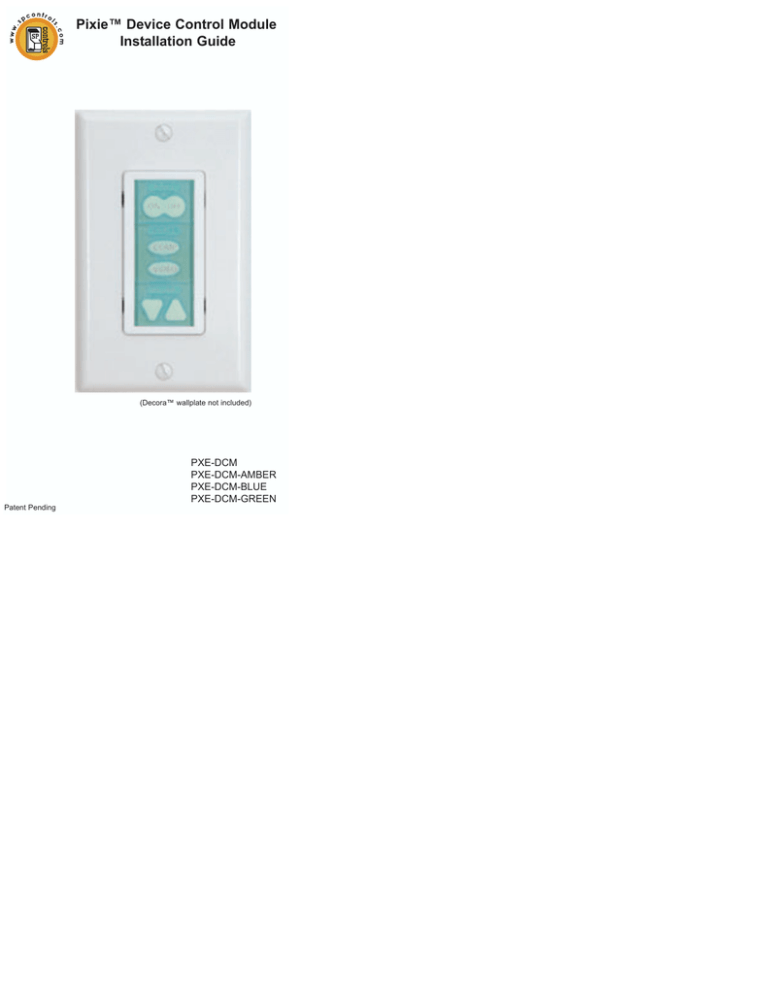
Pixie™ Device Control Module
Installation Guide
(Decora™ wallplate not included)
Patent Pending
PXE-DCM
PXE-DCM-AMBER
PXE-DCM-BLUE
PXE-DCM-GREEN
Contents
Important Safety Information
1
Electrical Warning
1
FCC Compliance
1
I. Introduction
2
II. Installation Overview
3
III. Wiring at Display Device
4
IV. Pixie Installation
1. Assemble Insert Modules
2. Attach Bezel
3. Wire Controller
4. Install Controller
5. Configure Pixie Audio Feedback (optional)
5
5
6
7
8
8
V. Program Pixie
9
VI. Cloning
14
VII. Complete Installation
15
VIII. Operation
16
IX. Troubleshooting
17
X. Technical Specifications
18
Warrany
19
Copyright
19
Important Safety Instructions
1) Read these instructions.
2) Keep these instructions.
3) Heed all warnings.
4) Follow all instructions.
5) Do not use this apparatus near water.
6) Clean only with dry cloth.
7) Do not block any ventilation openings. Install in accordance with the manufacturer's instructions.
8) Do not install near any heat sources such as radiators, heat registers, stoves, or
other apparatus (including amplifiers) that produce heat.
9) Do not defeat the safety purpose of the polarized or grounding type plug. A
polarized plug has two blades with one wider than the other. A grounding type plug
has two blades and a third grounding prong. The wide blade or the third prong is
provided for your safety. When the provided plug does not fit into your outlet, consult an electrician for replacement of the obsolete outlet.
10) Protect the power cord from being walked on or pinched particularly at plugs,
convenience receptacles, and the point where they exit from the apparatus.
11) Only use attachments/accessories specified by the manufacturer.
12) Use only with a cart, stand, tripod, bracket, or table specified by the manufacturer, or sold with the apparatus. When a cart is used, use caution when moving
the cart/apparatus combination to avoid injury from tip-over.
13) Unplug this apparatus during lightning storms or when unused for long periods
of time.
14) Refer all servicing to qualified service personnel. Servicing is required when
the apparatus has been damaged in any way, such as power-supply cord or plug is
damaged, liquid has been spilled or objects have fallen into the apparatus, the
apparatus has been exposed to rain or moisture, does not operate normally, or has
been dropped.
WARNING - To Reduce the Risk of Fire Or Electric Shock, Do Not Expose This
Apparatus To Rain Or Moisture.
Apparatus shall not be exposed to dripping or splashing and no objects filled with
liquids, such as vases, shall be placed on the apparatus.
Electrical Warning
The PXE-DCM is a low-voltage device. Never install the Pixie in an electrical
back box containing high-voltage wiring. This would cause a serious electrical
danger and violate United States national electrical codes.
1
I. Introduction
Mounting Screws
IR Transmitter
IR Learning
Window
Insert Modules
Status LED
Pixie Board
Learning Mode
Activation Switch
The Pixie™ (PXE-DCM, PXE-DCM-AMBER, PXE-DCM-BLUE, PXE-DCM-GREEN)
is a single-gang AV control device. A modular interface with 6 optional button
inserts enables control of almost any projector, plasma screen, or monitor available. The Pixie is field-programmed in minutes using IR-learning technology.
Multiple units may be quickly and easily configured using wireless cloning technology.
One Pixie can learn codes from multiple remote controls. A Pixie can control a second device using a second IR emitter (not included - SP Controls part no. PXEEMIT).
The Pixie is available in a variety of plastic/LED color combinations to customize
the look of your installation. Alternative bezels (not included) are available in black
(PXE-BEZEL-BL) and gray (PXE-BEZEL-GR).
The Pixie is designed for use with a Leviton Decora™ wall plate (not included).
The Pixie may be installed in a single-gang back box (not included).
Captive Screw
Connector
(wire to cable
assembly)
2
II. Installation Overview
Bezel
Inserts
Circuit Board
Single-Gang Wall Box
(not included)
The Pixie ships with:
- 1 Pixie DCM Circuit Board
- 6 White Plastic Button Inserts (model PXE-DCM) or
6 White Plastic and 6 Colored Plastic (models PXE-DCM-AMBER,
PXE-DCM-BLUE, and PXE-DCM-GREEN)
- 1 Cable Assembly consisting of:
1 Plastic Cable Assembly Block
1 Fiber Optic IR Light Pipe (attached)
1 6VDC Regulated Wall Wart-type Power Supply
Double-Sided Tape (attached to Block)
- 2 Bezels (ivory and white)
- 1 3-position Captive Screw Connector for power/IR out from Pixie
- Instruction Manual
- Quick Start Guide
- Mounting Screws
- Paper Clip (for setting to program mode)
Required and Optional parts (not included):
- 1 3-conductor Shielded Cable (Required. See Section III. Prepare Wiring for
more information)
- 1 Leviton Decora™ wall plate (Required. Match to bezel color.)
- 1 Single-Gang Back Box (Optional. SP Controls recommends using a grounded
back box)
- Additional IR emitter for control of second device (Optional. SP Controls part no.
PXE-EMIT)
3
III. Wiring at Display Device
Attention: The IR cable out from the Pixie cable
assembly is a fiber optic light pipe, not an IR emitter.
The IR light pipe cannot be extended.
3-conductor to
Pixie (see page 7)
DO NOT CUT the IR light pipe without proper
fiber optic cutting tools.
Installation
Wire the cable assembly to the Pixie using a three-conductor cable (not included). SP Controls recommends
using 18- or 22-gauge cable. Standard audio cable will
work (e.g. Belden™ 8451 or 9451).
1. Wire Cable Assembly Connect the three-conductor
cable to the screw down posts in the cable assembly
block. The three positions on the cable assembly
Fiber Optic
block are labeled: +6V, Gnd, and IR. Match the
conductors to the corresponding positions on the Light Pipe to IR
Receiver Window
Pixie captive screw connectors with identical
labels.
Connect
6V DC
2. Position IR Bud over receiver window of display device. Remove the light
pipe backing to expose the adhesive and secure bud to IR receiver window.
NOTE: The bud adhesive gradually solidifies and quickly becomes very strong,
making repositioning the bud difficult. Be sure that the bud is correctly placed The
adhesive will solidify to maximum strength in approximately 24 hours.
Some devices are extremely sensitive to exact bud placement. If possible, program
the Pixie and test the IR positioning before affixing the bud permanently with the
adhesive.
Unlike some IR emitters, the light pipe bud does not illuminate when it sends
signal.
Affix light pipe to device
with included anchors
Affix bud to IR Receiver
4
III. Wiring at Display Device cont’d
3. Anchor light pipe to display device with included anchors. The anchors will
position the light pipe in place and guide it around corners.
Use care not to bend the light pipe at a right angle. A kink in the light pipe
will damage it. Do not force the light pipe to bend at a right-angle around corners,
or you may damage the light pipe.
4. Draw the light pipe taught to place the cable assembly block. Affix the IR cable
assembly block to the AV display device using the included double-sided Velcro™
tape.
5. Connect power supply barrel connector to IR cable assembly block with the
included 6 VDC power supply.
IV. Pixie Installation
Each unit comes with a variety of button inserts to customize the Pixie interface to
match your device’s remote control. Select the combination of insert modules that
matches the design of the remote control.
1. Assemble Insert Modules
Power Insert Modules
Power insert modules are of two types: toggling and discrete. If the device remote control has separate buttons for POWER ON
and POWER OFF, use the discrete power
insert module. If the device remote control
has one toggling POWER control button, use
the toggling power insert module.
Toggling
Discrete
Source Insert Modules
Source insert modules are of two types:
toggling and discrete. If your remote has
separate buttons for COMPUTER and
VIDEO inputs, use the discrete source
insert module. If your remote control has
one toggling SOURCE control button, use
the toggling source insert module.
Toggling
Discrete
Note: Each source button may send as many as four distinct commands in round
robin. See Section V. Program Pixie below for more information.
5
IV. Pixie Installation cont’d
Volume
Volume insert modules are of two types:
control and blank. If you wish to control
volume on your device, use the control
insert module. If you do not wish to control
device volume, use the blank insert module.
Blank
Control
Note: You must chose one and only one insert module of each type. For example,
you cannot use two source insert modules.
2. Attach Bezel
Once you select the three insert modules appropriate for your device remote control, place the insert modules right-side-up against the circuit board. Secure them
into place with the bezel.
Be sure the bezel is correctly placed right side up. The SP Controls logo should
be in the correct orientation. The top side of the bezel has two small circular cutouts designed to fit over the IR receiver window and the Status LED.
Bezel
Inserts
Pixie
Board
Note: It is possible to remove the bezel from the
front of the unit after installation. Insert the tip of a
flathead precision screwdriver into the four slots
adjoining the bezel mounting pegs and gently lever
them inwards to free the bezel.
6
3. Wiring Controller
IV. Pixie Installation cont’d
Connect the 3-conductor cable to the captive screw connector on the back of the
Pixie. Be sure that the wires agree with the connections on the cable assembly
block end (page 4). For example, the wire landing at the 6V position on the cable
assembly block should connect to 6V position on the Pixie, et cetera.
Note: Verify the captive screw connectors are fully open (turned counterclockwise)
before inserting the wires. If the screws are turned the wrong way to secure the
wires, they can make a physical connection without making an electrical connection.
Note: The sequence of labeling is the same on the cable assembly block and the
Pixie; e.g. the Pixie uses cross-over wiring.
Wire landing must match
landing on cable assembly
block at the display device
side (see pg. 4).
7
4. Install Controller
IV. Pixie Installation cont’d
Optional: Mount the Pixie to a single-gang wall box (not included). The inner
screw holes on the Pixie PCB should be used to affix the Pixie to the wall box.
The outer screw holes will be used to affix a Decora™ wall plate over the face of
the Pixie (Part VII. Complete Installation).
Plug in the 6V wall wart to power the Pixie.
Warning: The PXE-DCM is a low-voltage device. Never install the Pixie be
installed in an electrical back box containing high-voltage wiring. This would
cause a serious electrical danger and violate United States national electrical
codes.
5. Configure Pixie Audio Feedback (optional)
By default, the Pixie will respond to button presses with an electronically-generated
click sound. To deactivate this sound, press and hold any button on the Pixie while
inserting a paperclip into the Pixie programming aperture. The Pixie will beep
quickly three times to indicate that AUDIO has been set to OFF.
Caution: Be gentle with the paper clip to ensure that you do not damage switch
mechanism.
8
V. Program Pixie
Programming Overview
The Pixie controls AV devices by learning and duplicating the IR codes of their
native remote controls. To configure the Pixie to control your device, you will set
the Pixie to Learning Mode, arm the key to be learned, and squirt it with the appropriate remote control commands.
The Status LED will blink red while the Pixie is in learning mode. While the Pixie is
receiving IR codes, the status LED will flicker rapidly.
Note: A single button can be configured to Macro mode, such that one button
press sends multiple IR commands. For more information, see the Pixie support
document Programming Macros (available for download at
www.spcontrols.com/pixie).
Note: If you are using learning a device manufactured by Philips or their OEM partners, including Magnavox and Koss, please consult the SP Controls PXE-DCM
Philips Protocol Application Note for special programming instructions. Contact SP
Controls or visit our web site at
www.spcontrols.com/pixie for more
information.
To learn a remote control:
1. Power the Pixie: While powered
the LED backlights will illuminate the
Pixie insert legends.
2. Enter Learning Mode: To set the
Pixie to Learning Mode, gently insert
a paper clip into the small hole
labeled "insert paper clip to enter
learning mode". The Pixie will
remain in Learning Mode while the
paper clip remains in the Learning
Mode aperture. Removing the paper
clip will return the Pixie to normal
operation.
Caution: Be gentle with the paper
clip to ensure that you do not damage the switch mechanism.
Be sure that you are not pressing
any of the Pixie buttons when you
insert the paper clip, or you will toggle the Pixie Audio Mode on or off (see Section
IV, Part 5 for more information).
If the room is too bright, you will not be able to set the Pixie to learning mode. The
LED will illuminate solid red, the buttons will beep as soon as they are pressed,
and they will not arm for learning. Should this occur, try to shield the Pixie
9
from the ambient light while learning. Direct sunlight is always too bright.
V. Program Pixie cont’d
3. Test Remote and Identify Sweet Spot: Before trying to learn any keys, position
your remote control a few inches from the IR learning eye (upper right of Pixie
front).
When you press a key on the remote, you should see the Pixie status LED flicker
red. Notice that as you move the remote closer and farther away from the receiver
window, or as you move "off axis" (away from perpendicular to the receiver window) the brightness of the red flashes will fall off and become intermittent. Identify
a position that seems to consistently yield clear, regular blinking of the red status
LED. This is the "sweet spot" most likely to provide the clean signal that the Pixie
needs to learn.
If you do NOT see the Status LED flicker rapidly, your remote may need new batteries.
Note: Some remotes have several emitting LEDs, which may not be located in the
center of the remote.
4. Single versus Round Robin Codes
A single button on the Pixie may be programmed with either a single command or
round robin commands. Single command buttons always send the same code.
Round robin buttons send multiple commands in series. Each time a round robin
button is pressed, it will send the next code in the series.
For example, a single command would be used for a POWER ON button. It will
always send only the POWER ON command.
A round robin command
is used if one button on the
Pixie must send multiple
codes. For example, a
remote control may have
several input selection buttons. Round robin commands should then be
used to associate multiple
input selection commands
with a single button on the
Pixie.
RGB1
RGB2
Video1
Video2
Remote Control
Input Selection
Module
The first time the COMP button is pressed, the Pixie will send the command for
RGB1. The second time the COMP button is pressed, the Pixie will send the command for RGB2.
The Pixie POWER, POWER ON, POWER OFF, VOLUME UP, and VOLUME
DOWN buttons may be programmed with as many as two codes. SOURCE,
COMP, and VIDEO may be programmed with as many as four codes.
10
V. Program Pixie cont’d
5. To program a button with a single code: While the Pixie is in learning mode,
press the appropriate button a single time to arm it. It should beep once and slowly
blink to indicate that it is armed for learning.
If the button beeps loudly as soon as you press it, check if the Status LED is solidly
illuminated. If it is, there may be too much ambient light in the room for learning.
Shield the Pixie from the ambient light source and try again.
Hold the remote control in the sweet spot you identified in step 3. Press and hold
the button on the remote for approximately one second. You should see the status
LED flicker, indicating that the code is being received. The Pixie will beep three
times quickly to indicate successful learning.
Arming will eventually time out if no IR code is received. You may select a different
key for learning at any time, including keys that are already learned. If you press a
key that is armed for learning, it is disarmed.
If the Pixie believes it successfully learned the code the key will begin flashing
quickly to indicate it is in VERIFICATION MODE. Go to Step 7, Verify Learned
Keys.
6. To program a button with round robin codes: While the Pixie is in learning
mode, quickly press the button that you wish to learn as many times as there are
codes to associate with that button. The Pixie will then beep once for each code it
expects to learn.
For example, if you wish to program a SOURCE button with three codes, you will
quickly press the SOURCE button three times. The Pixie will beep three times to
acknowledge it will learn three codes.
11
V. Program Pixie cont’d
If the button beeps loudly as soon as you press it, check to see if the Status LED is
solidly illuminated. If it is, there may be too much ambient light in the room for
learning. Shield the Pixie from the ambient light source and try again.
The armed key will indicate it is ready to learn the first code by flashing once,
pausing, flashing once, and so on.
Hold the remote control in the sweet spot you identified in step 3. Press and hold
the button on the remote for approximately one second. You should see the status
LED flicker, indicating that the code is being received. The Pixie will beep three
times quickly to indicate successful learning.
Now the button will indicate it is ready to learn the second code by flashing
twice, pausing, flash twice, and so on.
Repeat applying the code to the Pixie with the remote control. It will again beep
three times to indicate if the code was successfully learned.
When you have programmed the last code in the series, the Pixie will beep quickly
three times to indicate the code is successfully learned, and then beep slowly three
more times to indicate that the button has been fully programmed.
Arming will eventually time out if no IR code is received. You may select a different
key for learning at any time, including keys that are already learned.
If the Pixie successfully learns the code the key will begin flashing quickly to indicate it is in VERIFICATION MODE.
Note: You cannot add a new code
to a key that is already programmed. To change a button from
a Single Code to a Multiple Code,
you must reprogram it entirely.
Note: If any code fails to be
learned correctly, the entire learning
sequence for that key is started
over.
7. Verify Learned Keys:
Immediately after learning, each
key will blink rapidly to indicate that
it is ready for verification. Press the
key and verify that it was learned correctly. The red status LED and the Pixie will
emit the code as it was learned, and the device the Pixie controls should respond
appropriately. Note: the light pipe bud will not illuminate when sending codes.
Note: Because the Pixie will emit the code during this step, you may test that the
learned code will correctly control the device being learned.
If the key is a Single Code key, it will emit the same code each time the button is
pressed. If the key is a Round Robin Key, it will cycle through all of the codes it
has learned with each successive press.
12
V. Program Pixie cont’d
For remotes that implement a "press and hold repeat," verify that the code only
squirts for a moment if the key is pressed briefly, but continues to regularly emit if
the key is press-and-held.
To re-learn a key that did not seem to learn correctly, simply press any other key
on the keypad, then press the target again to rearm it.
8. Repeat for Each Button: While you are still in learning mode, program and verify each button.
9. To Erase All Keys: Press and hold any two buttons to erase the Pixie. The
whole keypad will begin blinking slowly to indicate that it is going to be erased.
Blinking will gradually quicken to CONFIRM DEVICE ERASE. After a few seconds
all keys will go dark and the Pixie will beep four times, indicating it has been
erased. Once a device has been erased there is no way to un-erase it.
10. To Exit Learning Mode: Gently remove the paper clip from the Learning Mode
aperture to exit Learning Mode. Be sure not to hold any buttons while removing the
paper clip, or the unit will be set to cloning mode (see page 14 ff.).
11. Final Test of Learned Codes: Verify that the IR light pipe bud has been placed
directly over the IR detector on the device the Pixie controls. Press the Pixie button
that you wish to test. A red LED inside the Cable Assembly block will blink when
the code is being sent, but the light pipe bud does not illuminate.
12. Troubleshooting: If the cable assembly LED blinks and you cannot control the
device, BE ABSOLUTELY SURE that the light pipe bud is located in the right place.
If it still does not work, test other programmed buttons. If some work but others do
not, try re-programming the buttons that do not work. Make sure that you press the
button on the remote that you are learning for at least one second.
If you have gone through all of these steps and still cannot control the device, it
may have an IR format that cannot be learned. Note that this is extremely rare and
it is much more like that the IR is miswired, the bud is improperly placed, et cetera.
Please contact SP Controls if you believe you have a device that cannot be controlled.
13
VI. Cloning
Cloning Overview
Any Pixie may quickly and easily copy all the codes from any other Pixie, eliminating the need for programming each unit individually.
When cloning the Pixie, there will be a donor unit and a clone unit. The donor
unit must already be programmed with the appropriate codes (see Section V
above). The clone unit will copy the donor unit's codes.
Both Pixies must have the same button inserts. For example, if the donor Pixie has
a toggling POWER button insert, the cloned Pixie must also have a toggling
POWER button insert. They may be of different colors.
In order to clone one Pixie to another, both units must be powered. The donor unit
will be installed at this stage and it should be powered normally.
To power the clone unit you may cut a short length of two- or three-conductor
cable to wire the terminal block with the attached power supply to the captive
screw connector on the back of the cloned Pixie. This is easier than removing the
power supply from the terminal block.
Cloning Procedure
1. Set the clone unit to cloning mode. Until the Pixie is programmed, you may
set it to cloning mode by pressing and holding any button while applying power.
If a Pixie has been programmed and you wish to set it to cloning mode, gently
insert a paper clip into the IR Learning aperture. Press and hold any button on the
clone unit and, while holding the button, remove the paper clip. The Pixie will rapidly chirp for as long as it remains in cloning mode. The Pixie will time out of cloning
mode in about 15 seconds, so have both devices on hand. If the Pixie times out of
cloning mode, simply repeat this procedure to return it to cloning mode.
Caution: Be gentle with the paper clip to ensure that you do not damage switch
mechanism.
2. Position the two units face-to-face, with both units held upright, approximately
one inch apart. They should be directly across from each other with the bezels
lined up. This will position the IR receiver window of the cloning Pixie directly
across from the IR transmitter in the donor Pixie.
Note: Be sure not to cover or obstruct the IR receiver window or transmitter with
your hands.
14
Cloning cont’d
Once the units are correctly
lined up, the donor Pixie will
automatically enter cloning
mode.
When the clone Pixie
makes contact with the
donor, its LED will also turn
solid red.
3. Hold the clone unit
steadily in front of the donor
for about 15 seconds. Both
units will chirp rapidly to
indicate their progress. If
the connection is broken
(the clone unit ceases to
chirp), reposition the clone
unit and the Pixies will pick
up where they left off. If
communication is broken for
a significant period of time
(about 15 seconds), the
clone unit will time out and
you will need to begin
cloning again.
approx. one inch apart
facing each other
4. When the clone unit has completed copying codes from the donor, it will beep
loudly 3 times and reset. You will see all of the button LEDs flicker in quick succession. After the Pixie has reset it will be fully operational, and it will have learned all
of the codes programmed into the donor unit.
The donor unit will remain in cloning mode for approximately 15 seconds until it
times out. It will then return to normal operation.
VII. Complete Installation
To complete the installation, secure a Leviton
Decora™ wall plate (not included) over the
face of the Pixie. The outer screw holes on the
Pixie should be used to secure the wall plate.
15
VIII. Operation
The Pixie must always be powered on. The LED backlit buttons will remain continually illuminated.
Power
Power button inserts are used to control
power on the projector or monitor. Toggling
power buttons will toggle power on and off;
discrete power buttons have independent
control for power on and off.
Toggling
Note: POWER buttons do not power the
Pixie on and off; the Pixie will always remain on.
Discrete
Source
Source button inserts are used to control
input selection on the projector or monitor.
Each source button may be programmed
with as many as four separate input commands. To select the desired input, press
the appropriate input selection button as
many times as necessary to cycle through
the available inputs.
Toggling
Discrete
Note: Some projectors or monitors will not allow switching to an input if a signal is
not present on that input.
Volume
Volume button inserts are used to control
volume on the projector or monitor.
Press the upward-facing volume button
(right side) to raise device volume. Press
the downward-facing volume button (left
side) to lower device volume.
Control
Blank
If the Pixie is not used to control volume, a blank button insert may be used.
16
IX. Troubleshooting
Programming Problems
Verify that the Pixie is in learning mode.
The Status LED continually blinks red when the Pixie is in learning mode. If the
Status LED is solid red and the Pixie beeps loudly each time you try to arm a key
for learning, the ambient light may be TOO BRIGHT. Shield the Pixie from the
ambient light sources and attempt to program.
Verify each code is correctly learned immediately after it has been programmed.
The button will blink rapidly to indicate it is in verification mode. Push the button
and the IR light pipe will emit the corresponding code.
When the Pixie is emitting a code in verification mode, you should see the Status
LED flicker at a consistent strength and frequency. If the flickering seems uneven,
verify that you are holding the remote control in the correct 'sweet spot' and
described in Section V, Part 3 above.
If the Status LED does not flicker rapidly when the remote control is emitting a
code, verify that the batteries in your remote control are fresh.
Operation Problems
The Pixie is not powering the projector/monitor on.
Verify that the projector or monitor powers on normally with its own remote control
or settop controls. If the projector does not power on with its own controls, it may
not be powered, or may require service. Consult the projector or monitor documentation for more information.
The Pixie is not controlling the projector/monitor.
Many devices are very sensitive to correct placement of the IR light pipe bud.
Confirm that the IR light pipe bud is positioned directly over the receiver component on the IR window of the device you are controlling.
Be sure that the code was programmed correctly - see programming troubleshooting entry above.
The device will not switch to one of the inputs.
Some display devices will not switch to certain inputs if there is no signal present
on that input.
Control is intermittent.
If you are using learning a device manufactured by Philips, Magnavox, or Koss,
please consult the SP Controls PXE-DCM Philips Protocol Application Note for
additional programming instructions.
If you are still unable to control your device, please contact SP Controls Technical
Support for further assistance.
17
X. Technical Specifications
Package Type
Single-Gang Decora Mounting
Dimensions
4.130” (h) x 1.745” (w) x .90” (d)
Weight (PCB with bezel and 3
insert modules)
2.5 oz
Power Supply
6VDC, 300mA
Output Type
IR Fiber Optic Light Pipe
Recommended Wire
18- to 22- Gauge Shielded
The Pixie is UL listed and CE certified.
18
Warranty
SP Controls warrants all Pixie products and accessories against defects in materials and workmanship for a period of three years from the date of purchase.
Although SP Controls thoroughly tested and reviewed this documentation, there is
no warranty, express or implied, with respect to quality, merchantability, or fitness
for a particular purpose. Therefore, the Pixie and accessories are provided "as-is"
and the purchaser assumes the entire risk as to quality and performance.
There are no obligations or liabilities on the part of the SP Controls Corporation for
consequential damages arising out of or in conjunction with the use or performance
of these products or other indirect damages with respect to loss of profit, revenue,
or cost of removal and/or replacement. Some states do not allow the exclusion or
limitation of incidental or consequential damages, so the above limitation or exclusion may not apply to you. This warranty gives you specific legal rights, and you
may also have other rights that vary from state to state. SP Controls' maximum liability shall not exceed the price paid by the user.
All implied warranties, including warranties for merchantability and/or fitness, are
limited in duration to three (3) years from the date of purchase. Proof of purchase
must be provided with any claim.
FCC Compliance
This equipment generates radio frequency energy and if not installed in
accordance with the manufacturer's instructions may cause radio interference.
This equipment complies with part 15, Subpart J of the FCC rules for a Class A
computing device. This equipment also complies with the Class A limits for radio
noise emission from digital apparatus set out in the Radio Interference Regulation
of the Canadian Department of Communications. These above rules are designed
to provide reasonable protection against such interference when operating the
equipment in a commercial environment. If operation of this equipment in a residential area causes radio frequency interference, the user and not SP Controls,
Inc., will be responsible.
COPYRIGHT
Pixie™, and the SP Controls switch logo are trademarks of SP Controls, Inc.
Decora™ is a registered trademark of Leviton Manufacturing Co. All other trademarks mentioned in this manual are the properties of their respective owners. No
part of this document may be reproduced or transmitted in any form or by any
means, electronic or mechanical, for any purpose, without express written permission of SP Controls, Inc.
© 2010 SP Controls, Inc. All rights reserved.
Changes or modifications made to this equipment not expressly approved by SP
Controls, Inc., could void the user's authority to operate the equipment.
SP Controls, Inc. assumes no responsibility for any errors that appear in this document. Information in this document is subject to change without notice
19





